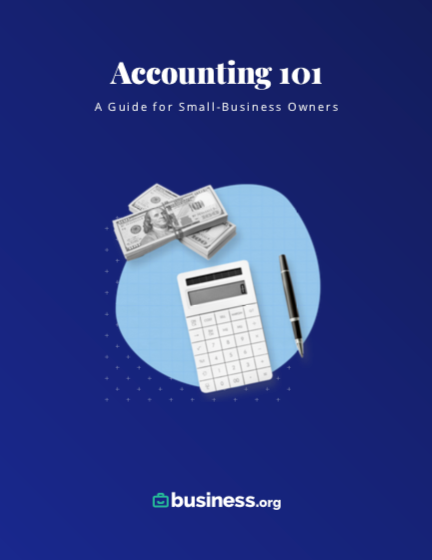We are committed to sharing unbiased reviews. Some of the links on our site are from our partners who compensate us. Read our editorial guidelines and advertising disclosure.
What Are Generally Accepted Accounting Principles?
If you’ve taken a financial accounting class in the past, then you may be familiar with the term GAAP. But what exactly is it? What are generally accepted accounting principles and why are they important?
In short, generally accepted accounting principles (GAAP) are a set of commonly followed accounting standards and rules for financial reporting. The standards include definitions, concepts, principles, and industry-specific rules. In other words, GAAP is a collection of concepts and best accounting practices accepted throughout the industry.
In this article, we’ll cover information about 10 key financial accounting principles, 4 main principles of GAAP, and some of the most common issues that small-business owners face today. Let’s get started.
Table of contents
Key small-business accounting principles
As a small-business owner, understanding basic financial accounting is essential to keeping your books clean. Let’s start by learning the top 10 accounting principles that can help you understand your company’s financial information.
Economic entity
This is one of the most fundamental yet sometimes overlooked accounting concepts. Small-business owners should keep their business finances separate from personal ones. If you own more than one business, you should keep separate financial records for each company—doing so will give you an accurate view of how your business is doing.
By signing up I agree to the Terms of Use and Privacy Policy.
Monetary unit assumption
This principle states that you should only record business financial transactions that can be expressed in currency. For example, in the United States, the currency would be the US dollar. Keep in mind that recordings are restricted to assets with objective monetary value and do not acknowledge the rate of inflation.
Cost principle
The cost principle requires an asset to be recorded at the cash amount at the time it was acquired. In other words, you want to record the exact amount you paid for or its original cost instead of the current value.
This accounting principle is essential for your small business as it helps ensure that you accurately value the expenses of your business assets. Additionally, the cost principle helps maintain consistent financial reporting.
Revenue recognition
If your small business is using the accrual basis accounting method, then you’ll want to use the revenue recognition principle. Revenue recognition states that you should record the revenue on your financial statements in the period it was earned and not necessarily when cash is received. In other words, revenue should be recognized at the time of sale regardless of when you receive payment.
For example, a lawn mowing company completes a service for a customer and charges a fee of $100. According to the revenue recognition principle, the company can recognize the $100 revenue immediately after completing the service—even if it doesn't receive payment until several weeks later.
Matching principle
The matching principle ensures that your business revenue and expenses are reported at the time they occur. Revenues and expenses are matched on your financial statement for a specific period of time such as a month, quarter, or year. For example, employee wages should be documented in the week they performed work, not the week when they actually receive their paycheck.
As part of the accrual accounting method, one of the benefits of this accounting principle is that it presents an accurate picture of your company’s operations on financial statements.
Conservatism principle
The conservatism principle states that you should anticipate losses and choose an alternative that will result in a less asset amount if you’re unsure about how to report an item. It also calls for potential liabilities and expenses to be recognized immediately.
Time period principle
Business financial activities may be reported in specific time intervals—such as months, quarters, fiscal year, or calendar year. The time interval must be identified on the heading of the company’s financial statements.
Going concern principle
This principle assumes that a company has enough resources necessary to operate until it provides evidence otherwise.
Materiality principle
In accounting, the term materiality means the relative size of an amount. Relatively large amounts are considered material while relatively small amounts are considered immaterial. Accordingly, the materiality principle states that an accounting rule can be ignored if the net impact has such a small impact on financial statements that the user would not be misled.
Full disclosure principle
Any information related to the business and relevant to an investor must be fully disclosed in the financial statements or the notes of the financial statements. This principle is especially important because it ensures that users and readers of the financial statements are not misled by a lack of information.
Key GAAP principles
To help you understand the mission of GAAP’s standards and rules, let’s dive into the four main principles you need to know.
Principle of consistency. This GAAP principle states that the reporting process should be standardized and that all items should be entered the same way they are fixed. This helps avoid discrepancies or errors.
Principle of regularity. This principle states that you must adhere strictly to the established GAAP rules and regulations.
Principle of sincerity. The sincerity principle states that you should provide an honest and correct picture of the company’s financial situation.
Principle of full disclosure. This important GAAP principle states that when creating financial statements, you must aim to fully disclose all necessary and relevant company financial information.
Common issues small-business owners deal with
Now that we’ve learned some key financial accounting concepts and GAAP principles, let’s talk about some of the most common issues small-business owners run into—and what it could mean for your business.
Failing to accurately record transactions
Proper accounting means recording everything on your financial statements—no matter how small the transaction is. It’s important that you record both large and small payments to get an accurate picture of your business finances.
As a small business owner, you’re probably wearing multiple hats. While everything you do is important to your business, one of the most significant things is to ensure that your finances are recorded accurately. Failure to do so could run into a lot of financial complications in the future.
Tax compliance
Taxes. It may not be a very fun topic, but it’s something business owners have to address—especially in terms of financial reporting.
As a small business, you will need to meet federal, state, and local tax obligations. Depending on your business structure and location, the amount of tax you have to pay will vary.
As tax laws vary by business structure and location, make sure you check with the state and local government to determine your company’s tax obligations. Generally speaking, the two most common types of local and state tax requirements for small businesses include income taxes and employment taxes.
The way you structure your small business will determine the taxes you owe to the federal government. In general, the five types of business taxes include income tax, self-employment tax, estimated tax, employer tax, and excise tax.
Worker misclassification
When it comes to financial reporting, one of the most common issues that small-business owners run into is misclassifying workers—specifically between employees and independent contractors. Worker classification is important as it determines whether an employer must withhold income taxes and pay social security.
According to the IRS, the general rule of thumb is that a worker is considered an independent contractor if they have the right to control or direct the result of the work. Small-business owners should consider the degree of independence and control within the employer-worker relationship. The classification of the workers will depend on the facts in each situation.
Small businesses can end up owing employment taxes if an employee is misclassified as an independent contractor.
Failing to reconcile books
It’s important for a small business to reconcile its financial statements regularly. Reconciliation is essentially the process of checking an account balance to ensure that it’s accurate and that the amount matches the balance in your bank account.
Small expenses you may forget about could go unrecorded, and this can affect the accuracy of your financial statements. Regularly reconciling your accounts allows you to accurately track your company’s financial information. It’s usually a good idea for small businesses to reconcile their books on a monthly basis.
Compare top picks for business accounting software
Data as of 3/9/23. Offers and availability may vary by location and are subject to change.
*Only available for businesses with an annual revenue beneath $50K USD
**Current offer: 90% off for 3 mos. or 30-day free trial
†Current offer: 50% off for three months or 30-day free trial
‡Current offer: 75% off for 3 mos. Available for new customers only
The takeaway
GAAP, the acronym for generally accepted account principles, is a set of commonly accepted accounting principles, procedures, and standards. Regardless of the size of your business, understanding basic accounting and GAAP principles can help give you a better overall picture of your company’s financial information. Of course, you could always hire a professional to handle all of your accounting needs, but it’s also a good idea to have a fundamental understanding to get a better picture of your financial situation.
Is your small-business interested in accounting software? Find what you need in our Best Small-Business Accounting Software resource guide.
Related content
Generally accepted accounting principles FAQ
Generally accepted accounting principles (GAAP) are commonly followed standards, concepts, principles, and industry-specific rules for financial reporting.
The four principles of GAAP include the principle of consistency, the principle of regularity, the principle of sincerity, and the principle of full disclosure.
The 10 generally accepted accounting principles include economic entity, monetary unit assumption, cost principle, revenue recognition, matching principle, conservatism principle, time period principle, going concern principle, materiality principle, and full disclosure principle.
Quizlet is a free website that provides a learning tool for students that includes flashcards and games. Users can learn and quiz themselves on topics such as generally accepted accounting principles.
Disclaimer
At Business.org, our research is meant to offer general product and service recommendations. We don't guarantee that our suggestions will work best for each individual or business, so consider your unique needs when choosing products and services.





